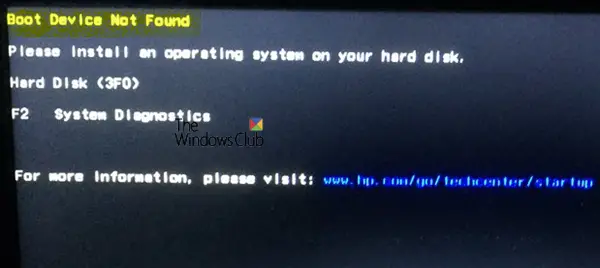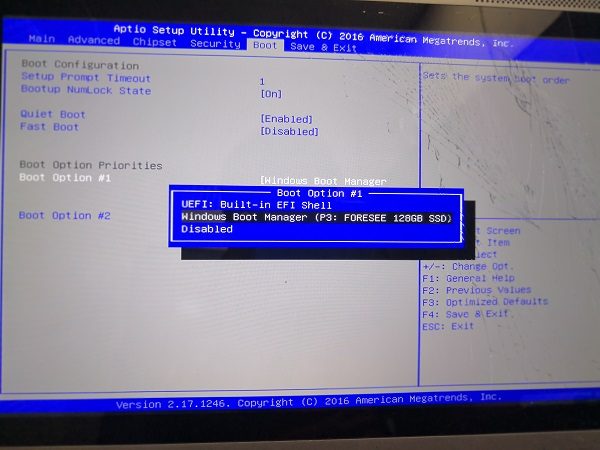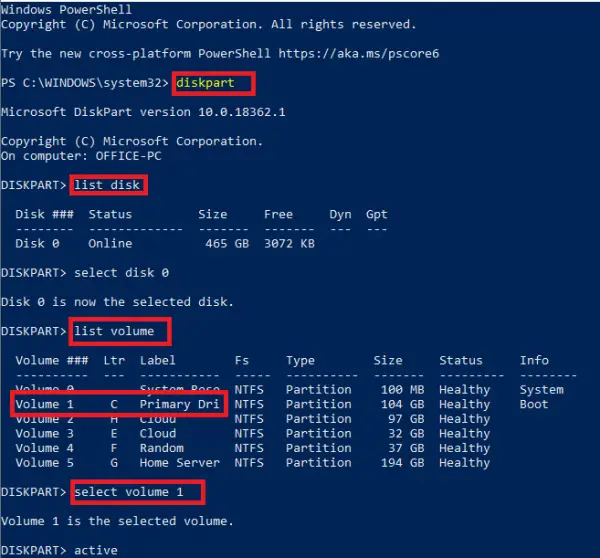When you turn on your working computer, which was working correctly, and see a message — Boot Device Not Found, then you are likely to break into a panic. Along with the error message, you may also see a message asking you to – Please install an operating system on your hard disk, Hard Disk<xxx>. You will also be asked to press F2 to initiate System Diagnostics.

What does the Boot device not found error mean?
When you install Windows on a drive, it becomes the boot device. When a computer boots, the BIOS or UEFI looks for the OS installed on that drive, and continues the process further. You can read about how Windows boots here. Coming back to the error code, when the BIOS or UEFI doesn’t find any device from which it can boot, it gives the error saying the boot device cannot be found.
Boot Device Not Found
These are the troubleshooting tips you can follow to overcome the Boot Device Not Found error. It could be a physical issue or a software issue.
- Check connection with the boot drive
- Change Boot Order
- Fix Boot Record from Recovery
- Check if Primary Partition is active
Make sure to prepare a bootable Windows USB drive. The last two option requires you to boot into Advanced Recovery Mode to execute commands.
1] Check connection with the boot drive
If you are using a custom PC that comes with a cabinet, we suggest you open it. Remove any connected power supply and check on the wires. Drives are connected with the motherboard through a cable. Check if both ends are connected well, and it’s not lost. It’s a good idea to detach and reattach and see if the boot works.
If you are using a laptop. You have two options. If you have the skills which help you open the laptop, and check for loose connection, go ahead. If not, take it to a service center if none of the other tips work.
2] Change Boot Order

When the computer boots, the BIOS or UEFI looks at the boot order. The order tells were to first look for a boot drive. If for some reason, a USB is connected to your computer, and the first boot device is USB, then you have sorted your problem. You can remove the USB and boot or get into the BIOS and change the Boot order.
If you are all good on the hardware, let’s try to fix it through the software. Use the bootable USB drive, boot into Advanced Recovery Mode, and open the Command Prompt.
Read: No bootable image found, notebook will shutdown
3] Fix Boot Record Not Found from Recovery
In the Command Prompt, we will use the bootrec command to rebuild BCD or otherwise known as Boot Configuration Data. It contains boot configuration parameters on how to start your Windows. If it is corrupted, then BIOS will not be able to find the boot drive. You can use bootrec /rebuildbcd.

Read our detailed post on how to Repair Master Boot Record, where we use the following command options:
bootrec /fixmbr bootrec /fixboot bootrec /scanos bootrec /rebuildbcd
Once done, when you boot the computer, it will detect the boot drive, and load Windows OS.
4] Check if Primary Partition is active

On a hard drive which has multiple partitions, the one where you install Windows is called a Primary Partition. Apart from being Primary, it needs to be an active partition. You need to use the DiskPart tool to activate the partition. Since we cannot access the GUI, we will execute it from the Command Prompt.
DiskPart list disk select disk 0 list volume select volume X (where x is the volume where Windows is installed) active exit
Once done, the primary drive will be active, and you will be able to boot into the computer without any problem. Make sure to select the right volume; else you will have to come back, and change it again.
TIP: Disabling Local Security Authority protection is known to have helped many resolve this issue.
Hope this helped.
Related reads: